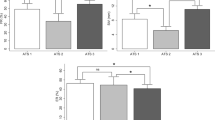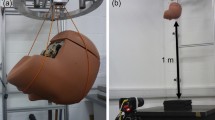Abstract
This study aims to re-examine to what extent the testing procedure of the Artificial Athlete Berlin (DIN18032) is a valid evaluation method to assess the shock absorbency of third generation artificial turf (3-g turf) and to establish a new testing procedure, which precisely reflects the acute load by human sports action. The DIN test was conducted for 3-g turfs with different infill component. The baseline of the load of acute human sports action was obtained from the ground reaction force underneath the standard type of 3-g turf sample during landing from a 55-cm height with minimal shock attenuation. For reproducing the force similar to such a hard landing, a testing rig was developed and the same 3-g turf samples were tested. The DIN test failed to distinguish most types of 3-g turf and was found to be inappropriate to evaluate the shock absorbency of the 3-g turf mainly due to bouncing actions of the test foot on measured samples. In contrast, the newly developed testing rig succeeded in illustrating the differences of shock attenuation properties among most types of 3-g turfs in a high loading condition. In terms of players’ safety, the necessity of high loading test using an alternative testing procedure was highlighted.






Similar content being viewed by others
References
Árnason Á, Gudmunsson Á, Dahl HA, Johannsson E (1996) Soccer injuries in Iceland. Scand J Med Sci Sports 6:40–45
Ekstrand J, Timpka T, Hägglund M (2006) Risk of injury in elite football played on artificial turf versus natural grass: a prospective two-cohort study. Br J Sports Med 40:975–980
Fuller CW, Clarke L, Molloy MG (2010) Risk of injury associated with rugby union played on artificial turf. J Sports Sci 28:563–570
Fuller CW, Dick RW, Corlette J, Schmalz R (2007) Comparison of the incidence, nature and cause of injuries sustained on grass and new generation artificial turf by male and female football players. Part 1: match injuries. Br J Sports Med 41:i20–i26
Fuller CW, Dick RW, Corlette J, Schmalz R (2007) Comparison of the incidence, nature and cause of injuries sustained on grass and new generation artificial turf by male and female football players. Part 2: training injuries. Br J Sports Med 41:i27–i31
Steffen K, Andersen TE, Bahr R (2007) Risk of injury on artificial turf and natural grass in young female football players. Br J Sports Med 41:i33–i37
Andersson E, Ekblom B, Krustrup P (2008) Elite football on artificial turf versus natural grass: movement patters, technical standards, and player impressions. J Sports Sci 26(2):113–122
Dixon SJ, Batt ME, Collop AC (1999) Artificial playing surfaces research: a review of medical, engineering and biomechanical aspects. Int J Sports Med 20:209–218
Nigg BM (1990) The validity and relevance of tests used for the assessment of sports surfaces. Med Sci Sports Exerc 22:131–139
Williams S, Hume PA, Kara S (2011) A review of football injuries on third and fourth generation artificial turfs compared with natural turf. Sports Med 41:903–923
Caple M, James I, Bartlett M (2012) Mechanical behavior of natural turf sports pitches. Sports Eng 15:129–141
Carré MJ, Haake SJ (2004) An examination of the Clegg impact hammer test with regard to the playing performance on synthetic sports surfaces. Sports Eng 7:121–129
Francis PR, Leigh M, Berzins A (1988) Shock absorbing characteristics of floor used for dance exercise. Int J Sport Biomech 4:282–305
Fujitake K, Yamamoto T, Takemura M (2007) A comparison of the mechanical characteristics of natural turf and artificial turf football pitches. Footb Sci 4:1–8
Huang TJ, Chang LT (2009) Design and evaluation of shock absorbing rubber tile for playground safety. Mater Design 30:3819–3823
Dixon SJ, Stiles VH (2003) Impact absorption of tennis shoe-surface combinations. Sports Eng 6:1–10
Durá JV, Hoyos JV, Lazano L, Martínez A (1999) The effect of shock absorbency sports surfaces in jumping. Sports Eng 2:103–108
Kolitzus HJ (1984) Functional standards for playing surfaces. In: Frederick EC (ed) Sport shoes and playing surfaces: biomechanical properties. Human Kinetics Publishers Inc, IL, pp 98–118
Andréasson G, Lars P (1986) Effects of shoe and surface characteristics on lower limb injuries in sports. Int J Sport Biomech 2:202–209
DIN (1991) DIN Standard 18032-2. Sports halls; halls for gymnastics and games; floors for sporting activities, requirements, testing. Deutsches Institut Fur Normung, Berlin, Germany
Harrison M (1999) Factors affecting the results of the ‘Berlin Artificial Athlete’ test. http://www.isss-sportsurfacescience.org/page.asp?node=34&page=1&action=readmore&r_s=33324.86&tid=49. Accessed 18 April 2013
International Association of Athletics Federations (2009) IAAF Certification system: track facilities testing protocols. http://www.iaaf.org/mm/Document/Competitions/TechnicalArea/04/85/77/20110414053903_httppostedfile_CertSys11_2_24133.pdf. Accessed 31 Aug 2012
International Basketball Federation (2010) Official basketball rules 2010. http://www.fiba.com/downloads/Rules/2010/OfficialBasketballRules2010.pdf. Accessed 31 Aug 2012
Fédération Internationale de Football Association (2008) FIFA quality concept for football turf. http://www.fifa.com/mm/document/afdeveloping/pitch&equipment/50/15/94/footballturfbookletenglish_07012009.pdf. Accessed 31 Aug 2012
International Rugby Board (2008) Regulation 22: Standard relating to the use of artificial playing surfaces. http://www.irb.com/mm/document/lawsregs/0/regulation22080611_6080.pdf. Accessed 31 Aug 2012
Blackburn S, Nicol AC, Walker C (2005) Development of a biomechanically validated turf testing rig. In: Proceedings of the XXth Congress of the International Society of Biomechanics, Cleveland State University, Ohio, p 120
Wisløff U, Castagna C, Helgerud J, Jones R, Hoff J (2004) Strong correlation of maximal squat strength with sprint performance and vertical jump height in elite soccer players. Br J Sports Med 38:285–288
Chamari Y, Hachana Y, Ahmed YB, Galy O, Sghaïer F, Chatard JC, Hue O, Wisløff U (2004) Filed and laboratory testing in young elite soccer players. Br J Sports Med 38:191–196
McNitt-Gray JL (1993) Kinetics of the lower extremities during drop landings from three heights. J Biomech 26:1037–1046
Midigan ML, Pidcoe PE (2003) Changes in landing biomechanics during a fatiguing landing activity. J Electromyogr Kines 13:491–498
Yeow CH, Lee PV, Goh JC (2011) An investigation of lower extremity energy dissipation strategies during single-leg and double-leg landing base on sagittal and frontal plane biomechanics. Hum Mov Sci 30:624–635
Author information
Authors and Affiliations
Corresponding author
Rights and permissions
About this article
Cite this article
Nunome, H., Inoue, K., Shinkai, H. et al. A novel comparison between standard and new testing procedures to assess shock absorbency of third generation artificial turfs. Sports Eng 17, 103–112 (2014). https://doi.org/10.1007/s12283-013-0146-7
Published:
Issue Date:
DOI: https://doi.org/10.1007/s12283-013-0146-7




